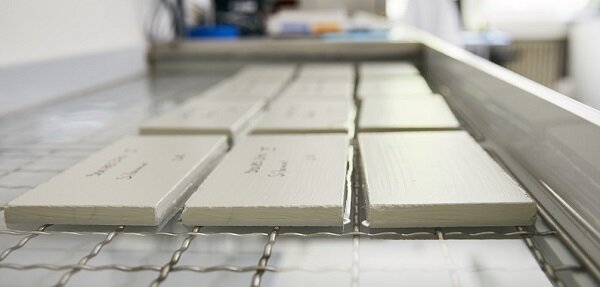
Exterior coatings
In contrast to interior coatings, exterior coatings are exposed to weathering. Due to these different stresses, the coatings are classified according to other assessment criteria and, accordingly, according to another standard, DIN EN 1062-1, which classifies the exterior coatings according to the type of binder, state of solution or dispersion, gloss*, dry film thickness*, grain size, water vapour diffusion current density*, permeability to water*, crack bridging and CO2 permeability. The permeability for water* and the water vapour diffusion current density* are of particular importance for the quality of an exterior coating.
Water permeability*

Water permeability describes how well the substrate is protected from rain or how much water passes through the coating into the substrate on contact with water. The result of this test is the so-called w-value, which is measured according to DIN EN 1062-3. The coating to be tested is applied to a sand-lime brick as the substrate and the back and jacket sides are sealed waterproof. The sand-lime brick is highly absorbent, so that all water that diffuses through the coating is absorbed by sand-lime brick. The coated side is immersed in a water basin at a depth of approx. 1 cm for 24 hours.
Water vapour permeability*
The water vapour diffusion current density describes how well moisture in the form of water vapour can diffuse out of the substrate and through the coating.
The V-value is measured according to ISO 7783. The coating to be tested is applied to highly porous frits. The coated frits are placed on a plastic box and sealed all around. In this plastic box there is a special salt solution which sets a relative humidity of 93 %. The test takes place in a climatic room at 23 °C and 50 % relative humidity. Due to the partial pressure gradient of 93 % relative humidity to 50 % relative humidity, the water vapour diffuses through the coating to the outside of the climatic chamber. Over time, the test specimen becomes lighter and lighter. The water vapour diffusion current density can be calculated from the loss of mass, the defined test area and time.
The test takes place in a climatic room at 23 °C and 50 % relative humidity. Due to the partial pressure gradient of 93 % relative humidity to 50 % relative humidity, the water vapour diffuses through the coating to the outside of the climatic chamber. Over time, the test specimen becomes lighter and lighter. The water vapour diffusion current density can be calculated from the loss of mass, the defined test area and time.
The sd-value describes the diffusion-equivalent air layer thickness of a coating and can be calculated from the V-value using a conversion factor.
* Accredited test


